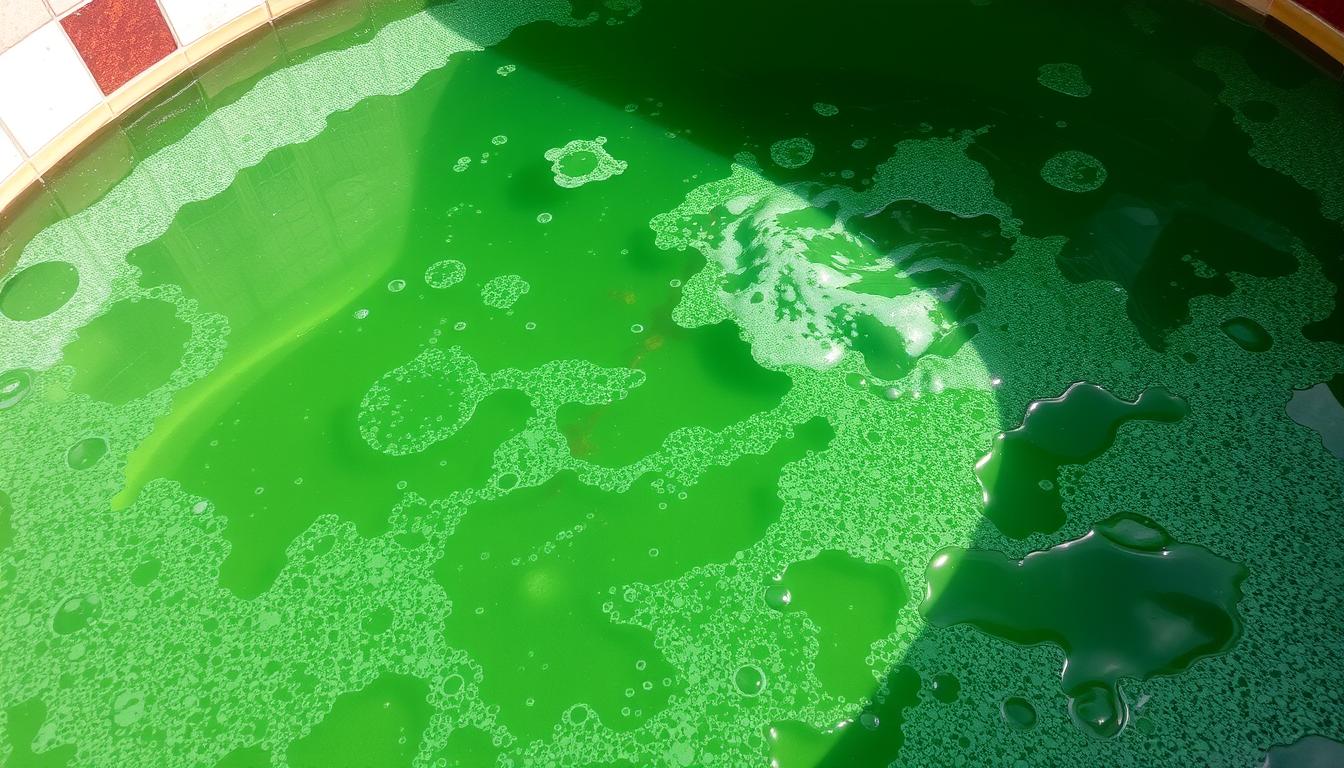
Hot tub owners dream of soaking in crystal-clear water that melts away stress. However, slimy hot tub water can quickly ruin this relaxing experience. Biofilm, or hot tub slime, is a common issue for many spa enthusiasts.
This slippery substance ruins the look of hot tubs and poses health risks. It clings to walls and floats on the surface, turning a spa into an uninviting mess.
But don’t worry! With the right knowledge and actions, you can fight hot tub slime. You can restore your spa to its clean, inviting state.
We’ll explore the causes of slimy hot tub water, including heavy use and pollutants. We’ll also look at bacterial growth and chemical imbalances. You’ll learn practical solutions to keep your hot tub water clean and clear.
Let’s uncover why your hot tub is slimy and how to fix it. We’ll help you enjoy a well-maintained, healthy hot tub again.
Key Takeaways
- Slimy hot tub water, or biofilm, is a common issue caused by various factors such as heavy usage, pollutants, bacteria, and chemical imbalances.
- Biofilm consumes sanitizer, affects pH and water balance, harbors harmful bacteria, causes foam and other water problems, and can even reduce pipe diameter in severe cases.
- All hot tubs are susceptible to biofilm, but it can be removed and prevented with proper maintenance and purging techniques.
- Regular testing and adjusting of pH, alkalinity, and sanitizer levels are crucial for maintaining clear and healthy hot tub water.
- Effective solutions for slimy hot tub water include shock treatments, cleaning or replacing filters, and using algaecides or water clarifiers.
- Implementing a consistent maintenance schedule and addressing the root causes of biofilm formation can help prevent the recurrence of slimy hot tub water.
Common Causes of Slimy Hot Tub Water
Slimy hot tub water can ruin your relaxing soak. Understanding what causes this issue helps keep your hot tub clean. Let’s explore the main reasons behind slimy water and how to prevent them.
Heavy Hot Tub Usage
Frequent hot tub use can quickly lead to cloudy and slimy water. Bathers introduce body oils, lotions, and other contaminants into the water. Monitor and adjust sanitizer levels often to combat this issue.
Perform deep cleaning after periods of heavy use. This helps maintain the delicate balance of hot tub water chemistry.
Pollutants and Organic Debris
Pollen, dust, and insects can enter your hot tub water. These pollutants feed bacteria and algae, causing slimy conditions. Skim the water surface regularly to remove debris.
Use a hot tub cover to minimize external pollutants. This simple step helps maintain clearer water in your spa.

Bacteria and Algae Growth
Hot tubs create ideal conditions for bacteria and algae growth. Low sanitizer levels allow these microorganisms to multiply rapidly. This can result in slimy, cloudy water.
Green water indicates algae presence. White flakes may signal biofilm, a stubborn bacteria group. Maintain proper sanitizer levels and shock the water regularly to prevent these issues.
Chemical Imbalance
Incorrect use of hot tub chemicals can lead to pH and alkalinity imbalances. These create an environment that promotes bacteria and algae growth. Test and adjust water chemistry regularly to maintain a clean hot tub.
Ineffective Filtration System
A poorly maintained filter fails to remove particles effectively. This contributes to slimy water conditions. Dirty filters can harbor bacteria and allow organic matter buildup.
Clean or replace hot tub filters regularly. This ensures optimal filtration efficiency and helps maintain clear, inviting water.
Body Care Products and Dead Skin Cells
Adults use many personal care products daily. These introduce numerous ingredients into the hot tub water. Body oils, makeup, and dead skin cells can accumulate, leading to foaming.
Encourage bathers to shower before entering the hot tub. Maintain proper sanitizer levels to mitigate the impact of personal care products.
| Cause | Effect | Prevention |
|---|---|---|
| Heavy Hot Tub Usage | Cloudy and Slimy Water | Monitor Sanitizer Levels, Deep Clean Regularly |
| Pollutants and Organic Debris | Bacteria and Algae Growth | Skim Water Surface, Use Hot Tub Cover |
| Bacteria and Algae Growth | Green Water, White Flakes, Biofilm | Maintain Proper Sanitizer Levels, Shock Water Regularly |
| Chemical Imbalance | Cloudy Water, Promotes Microbial Growth | Test and Adjust Water Chemistry Regularly |
| Ineffective Filtration System | Cloudy and Foamy Water, Bacteria Buildup | Clean or Replace Filters Regularly |
| Body Care Products and Dead Skin Cells | Foaming, Biofilm Formation | Encourage Pre-Soak Showers, Maintain Sanitizer Levels |
Why Is My Hot Tub Slimy? Effective Solutions
Slimy or slippery hot tub water needs immediate attention. It can pose health risks and ruin your soaking experience. Let’s explore some effective solutions to tackle this issue.
Test and Adjust Water pH and Alkalinity Levels
Start by testing pH and alkalinity levels with test strips or liquid kits. The ideal pH range is 7.2 to 7.8. Total alkalinity should be between 80 and 120 ppm.
Use pH adjusters and alkalinity increasers to balance levels if needed. Proper levels prevent bacteria and algae growth, which cause sliminess.
Perform a Shock Treatment
Shock treatments eliminate organic matter and contaminants causing slimy water. Use chlorine or non-chlorine shock as per your sanitizer type. Follow the manufacturer’s instructions carefully.
These treatments break down oils, lotions, and pollutants. They help restore water clarity and prevent biofilm buildup.
Shock treatments, such as chlorine shock or non-chlorine shock, break down contaminants and organic waste to improve water quality.
Clean or Replace Hot Tub Filters
Clean filters weekly with a garden hose. Treat them monthly with a filter cleaner. This removes oils, grease, and other buildup.
Replace filters every 6-12 months or sooner if damaged. Well-maintained filters prevent debris accumulation that leads to sliminess.
Use Algaecide or Water Clarifier
If algae growth causes sliminess, use a hot tub-specific algaecide. It kills and prevents algae growth, improving water clarity.
Follow up with a water clarifier to coagulate small particles. This makes them easier for the filtration system to remove.
As a last resort, drain and refill the hot tub with fresh water.
| Problem | Solution |
|---|---|
| Unbalanced pH and alkalinity | Test and adjust levels using pH and alkalinity increasers or decreasers |
| Organic matter and contaminants | Perform a shock treatment using chlorine or non-chlorine shock |
| Dirty or clogged filters | Clean filters weekly, treat monthly with filter cleaner, and replace every 6-12 months |
| Algae growth | Use an algaecide followed by a water clarifier |
These hot tub cleaning and maintenance solutions combat slimy water effectively. They ensure a clean, safe, and inviting hot tub experience.
Conclusion
Clean, healthy hot tubs ensure safe and enjoyable soaking. Understanding common causes of slimy water helps prevent issues. Proper care involves regular testing, adjusting water chemistry, and cleaning filters.
A consistent hygiene routine is crucial for top-notch hot tub condition. Drain and refill water every 3-4 months. Clean the shell, jets, and filters during each change. Maintain proper chemical levels to prevent biofilm growth.
Proper hot tub care enhances soaking and extends its lifespan. Follow these guidelines for a clean, healthy environment. Enjoy your hot tub’s benefits for years without worrying about slimy water.







